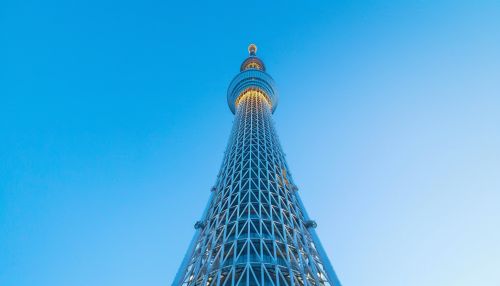Tokyo Skytree: Difference between revisions
(Created page with "== Overview == The **Tokyo Skytree** is a broadcasting, restaurant, and observation tower located in Sumida, Tokyo, Japan. It is the tallest structure in Japan and the second tallest in the world, standing at a height of 634 meters (2,080 feet). The tower was completed on February 29, 2012, and opened to the public on May 22, 2012. Tokyo Skytree serves as the primary television and radio broadcast site for the Kanto region. == Design and Architecture == The design of...") |
No edit summary |
||
| Line 15: | Line 15: | ||
The construction of Tokyo Skytree utilized high-strength steel and reinforced concrete. The steel used in the tower's construction was specially designed to be both lightweight and durable, ensuring the structure's stability and longevity. The outer frame is covered with a lattice of steel beams, giving the tower its distinctive appearance. | The construction of Tokyo Skytree utilized high-strength steel and reinforced concrete. The steel used in the tower's construction was specially designed to be both lightweight and durable, ensuring the structure's stability and longevity. The outer frame is covered with a lattice of steel beams, giving the tower its distinctive appearance. | ||
[[Image:Detail-93319.jpg|thumb|center|Tokyo Skytree tower against a clear blue sky.|class=only_on_mobile]] | |||
[[Image:Detail-93320.jpg|thumb|center|Tokyo Skytree tower against a clear blue sky.|class=only_on_desktop]] | |||
== Functions and Facilities == | == Functions and Facilities == | ||
Latest revision as of 09:20, 22 June 2024
Overview
The **Tokyo Skytree** is a broadcasting, restaurant, and observation tower located in Sumida, Tokyo, Japan. It is the tallest structure in Japan and the second tallest in the world, standing at a height of 634 meters (2,080 feet). The tower was completed on February 29, 2012, and opened to the public on May 22, 2012. Tokyo Skytree serves as the primary television and radio broadcast site for the Kanto region.
Design and Architecture
The design of Tokyo Skytree was inspired by traditional Japanese architecture and modern design principles. The tower's structure is a combination of a tripod base that transitions into a cylindrical form as it rises. This design provides both stability and aesthetic appeal.
Structural Engineering
Tokyo Skytree's structural engineering was a significant feat, incorporating advanced techniques to withstand earthquakes and strong winds. The tower features a central column, known as the shinbashira, which acts as a counterweight to reduce swaying during seismic activity. This design is reminiscent of traditional Japanese pagodas, which have historically demonstrated resilience against earthquakes.
Materials
The construction of Tokyo Skytree utilized high-strength steel and reinforced concrete. The steel used in the tower's construction was specially designed to be both lightweight and durable, ensuring the structure's stability and longevity. The outer frame is covered with a lattice of steel beams, giving the tower its distinctive appearance.


Functions and Facilities
Tokyo Skytree serves multiple purposes, including broadcasting, tourism, and commercial activities. The tower is equipped with state-of-the-art broadcasting equipment, ensuring high-quality transmission for television and radio stations.
Broadcasting
The primary function of Tokyo Skytree is to serve as a broadcasting tower. It replaced the Tokyo Tower as the main broadcasting site for the Kanto region. The height of Tokyo Skytree allows for a wider transmission range and improved signal quality, addressing the limitations faced by the older Tokyo Tower.
Observation Decks
Tokyo Skytree features two observation decks: the Tembo Deck and the Tembo Galleria. The Tembo Deck is located at 350 meters and offers panoramic views of Tokyo. The Tembo Galleria, situated at 450 meters, provides an even higher vantage point, allowing visitors to see as far as Mount Fuji on clear days.
Restaurants and Shops
The tower houses several restaurants and shops, catering to both tourists and locals. The Sky Restaurant 634, located on the Tembo Deck, offers fine dining with a view. Additionally, the tower complex includes the Tokyo Solamachi shopping mall, which features a variety of retail stores, eateries, and entertainment options.
Construction and Development
The construction of Tokyo Skytree was a massive undertaking, involving numerous engineering challenges and innovations. The project was managed by Tobu Railway and a consortium of six broadcasting companies.
Timeline
- **2008**: Construction began in July. - **2010**: The tower reached its full height of 634 meters in March. - **2012**: Construction was completed in February, and the tower opened to the public in May.
Challenges
One of the primary challenges faced during construction was ensuring the tower's stability in a seismically active region. Engineers employed various techniques, including the central column and tuned mass dampers, to mitigate the effects of earthquakes and strong winds.
Cultural Significance
Tokyo Skytree has become an iconic symbol of Tokyo and a popular tourist destination. Its design reflects a blend of traditional Japanese aesthetics and modern engineering, making it a unique landmark.
Symbolism
The height of 634 meters was chosen for its phonetic similarity to "Musashi," an old name for the Tokyo region. This choice reflects the tower's connection to the local culture and history.
Events and Illumination
Tokyo Skytree is often illuminated for special events and holidays, adding to its cultural significance. The tower features a variety of lighting schemes, including seasonal themes and commemorative displays.
Environmental Impact
The construction and operation of Tokyo Skytree have been designed with environmental sustainability in mind. The tower incorporates several eco-friendly features, including energy-efficient lighting and advanced waste management systems.
Energy Efficiency
Tokyo Skytree uses LED lighting, which significantly reduces energy consumption compared to traditional lighting methods. The tower also employs a heat recovery system to minimize energy waste.
Waste Management
The tower complex includes a comprehensive waste management system, ensuring that waste is sorted and recycled efficiently. This system reduces the environmental impact of the tower's operations and promotes sustainability.
